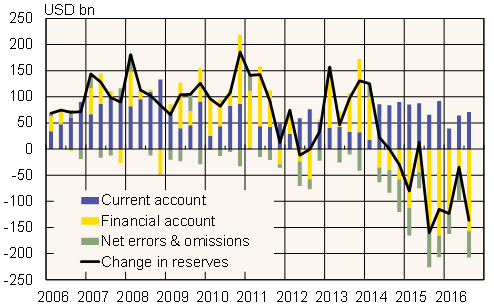BOFIT Weekly Review 45/2016
China’s current account surplus insufficient to cover capital outflows; currency reserves fall
Preliminary third-quarter balance-of-payments figures show that China’s current account surplus corresponded to 2.4 % of GDP, down from about 3 % in 3Q15. In dollar terms, the current account was slightly larger than in the second quarter, but the outflow of capital in net terms accelerated. For the past two years, the current account surplus has been inadequate to cover the deficit created by capital outflows. In the third quarter, China’s foreign currency reserves fell by $136 billion. Of that, over $30 billion represented a deficit in foreign direct investments. Capital outflow is also characterised by the fact that a big part of it is difficult to categorise, which is reflected in an increase in the net errors and omissions term.
The balance-of-payments situation in October seems to show little change from previous months, with goods trade still sluggish. The value of exports fell 7 % in dollar terms, while imports were down 1 % from a year earlier. The October goods trade surplus rose slightly from the previous month to nearly $50 billion. While data on October services trade is still unavailable, the services trade deficit seems to be roughly unchanged based on the spending of travellers abroad, and thus should offset the goods trade surplus by about half. China remained a net exporter of capital last month as its currency reserves fell by $45 billion to $3.121 trillion. However, the drop was partly due to exchange rate fluctuations.
To defend the yuan’s exchange rate, Chinese officials have attempted for some time now to restrict forex flows out of the country through such measures as tighter enforcement of existing rules and plugging loopholes with new regulations. Foreign trade pricing, forex purchases of Chinese tourists, buying insurance policies in Hong Kong and bitcoin transactions have all been mentioned as ways of circumventing current regulations.
Quarterly changes in China’s balance-of-payments accounts*

*3Q 2016 “net errors and omissions” term assumed to match the previous quarter
Source: Macrobond.